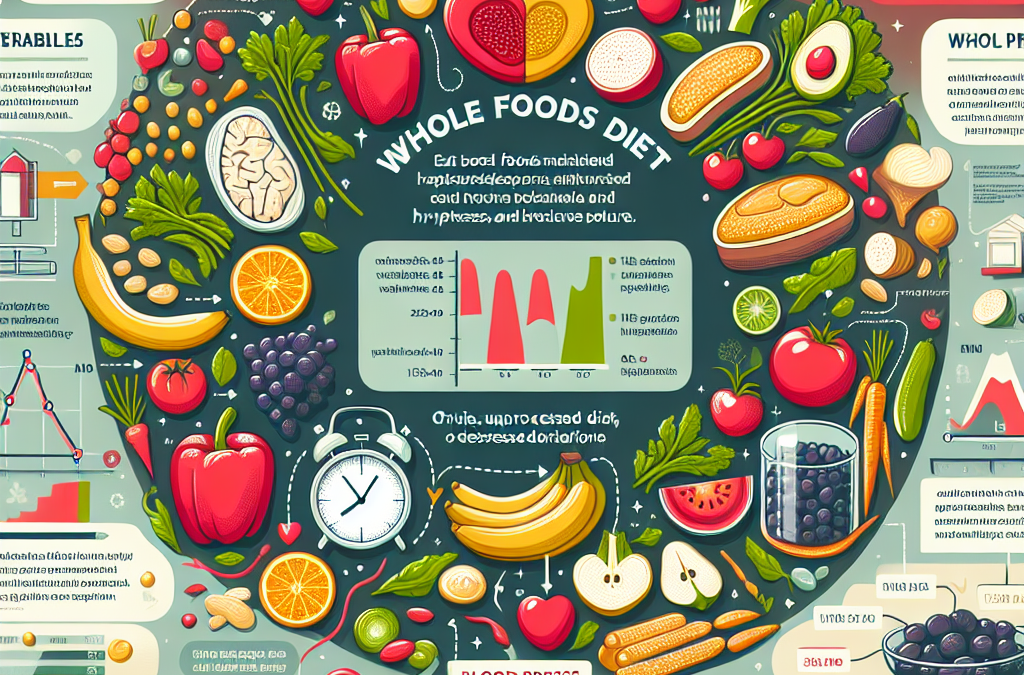Understanding Whole Foods and Blood Pressure
What Are Whole Foods?
So, let’s dive into the world of whole foods. Whole foods are basically foods that are as close to their natural state as possible. We’re talking fresh fruits, vegetables, whole grains, nuts, seeds, and legumes—pretty much the good stuff! Unlike processed foods, which often come in flashy packaging and are packed with unhealthy additives, whole foods offer a wholesome alternative that your body can recognize and utilize effectively.
Why does this matter for blood pressure? Well, whole foods are typically rich in essential nutrients like potassium, magnesium, and fiber. These nutrients play a critical role in helping to balance out the sodium levels in our body, which can significantly impact blood pressure management. The bottom line is, the more whole foods you incorporate into your diet, the better your body can regulate blood pressure levels!
From my personal experience, swapping out processed snacks for whole food alternatives made a noticeable difference in how I felt overall. It’s like my body finally got a chance to work with what it actually needed instead of struggling against all those additives.
How Diet Affects Blood Pressure
Now, let’s talk about how diet can significantly influence blood pressure. Our bodies react to the foods we eat, and maintaining a balanced diet with whole foods is essential for managing hypertension. High sodium intake is often linked to increased blood pressure, and many processed foods are heavy on salt. By focusing on whole foods, you can naturally lower your sodium intake and build meals that nourish rather than hinder your health.
Additionally, a diet rich in fruits and vegetables has been associated with lower blood pressure. These foods are not only low in calories but are also high in antioxidants, which can improve blood vessel function and support overall cardiovascular health. I’ve found that creating colorful plates filled with various whole foods has made my meals more visually appealing and delicious while doing wonders for my blood pressure!
After integrating more whole foods into my diet, I’ve witnessed tangible benefits—not just an improvement in my blood pressure readings but also a boost in my energy levels and a more balanced mood. It’s crazy how much our diet impacts everything, isn’t it?
Key Nutrients for Blood Pressure Control
Potassium-Rich Foods
Potassium is one of those superheroes in the world of nutrients and plays a crucial role in blood pressure management. It helps balance out the negative effects of sodium and eases tension in your blood vessel walls. Foods rich in potassium include bananas, sweet potatoes, spinach, and avocados. These are all considered whole foods that are super easy to incorporate into meals or snacks.
When I discovered the power of potassium, I started adding more of these foods to my smoothies and salads. I’ve noticed that it just adds this creamy texture and makes everything taste better. Who knew being health-conscious could also be tasty?
Eating a potassium-rich diet has not only been beneficial for my blood pressure but has also improved my muscle function and overall electrolyte balance. It’s pretty incredible how one nutrient can have such a widespread impact!
Magnesium’s Role
Next up is magnesium—another essential nutrient that supports healthy blood pressure levels. Magnesium helps regulate blood pressure by enhancing blood vessel function and improving inflammation levels. Whole foods that provide magnesium include nuts, seeds, leafy greens, and whole grains.
I started snacking on almonds and pumpkin seeds, and I swear they helped satisfy my cravings while also packing a nutritious punch. It’s like I’ve found my go-to snacks that are both delicious and beneficial!
Since increasing my magnesium intake, I’ve felt more relaxed overall. There’s something about knowing I’m fueling my body with good stuff that really eases my mind. Plus, magnesium is known to help people sleep better—another perk for managing stress related to blood pressure!
The Power of Fiber
Now let’s not forget dietary fiber! Whole foods like oats, beans, lentils, and berries are fiber powerhouses. Fiber can help manage blood pressure by supporting weight loss and improving heart health, which are crucial for those looking to lower hypertension risk.
Believe me, incorporating high-fiber foods into my meals has helped me feel fuller for longer. It’s like my stomach’s in on a secret that I found the magic trick to keep cravings at bay! Those fiber-filled meals not only taste great but keep my cardiovascular system happy.
Switching my focus to high-fiber options made my meals more satisfying. I can’t remember the last time I felt like snacking on junk food after a hearty bowl of oatmeal topped with berries. It’s a simple yet effective way to manage blood pressure while still enjoying food!
Preparing Meals with Whole Foods
Simple Meal Prep Ideas
Meal prepping with whole foods doesn’t have to be complicated. Start by choosing a few staples—think brown rice, quinoa, or whole-grain pasta—and build from there. I usually cook a big batch at the beginning of the week, which helps save time and make healthier eating easier. It’s a life-saver!
For instance, I love making a colorful quinoa salad loaded with fresh veggies, beans, and a zesty dressing. It keeps well in the fridge and is an easy, nutritious option for lunch or dinner. Getting creative with whole foods allows you to mix flavors and find combinations that work for you!
By making meal prep a priority, I’ve found that I’m less likely to grab unhealthy snacks when I’m hungry. Having those wholesome meals ready to go means I can quickly fuel my body with good stuff!
Cooking Techniques for Whole Foods
How you cook your whole foods matters too! Steaming, grilling, or roasting vegetables helps preserve their nutrients, while frying or overcooking might counteract the health benefits. I find that simple methods like sautéing veggies in olive oil with herbs add so much flavor without any fuss.
Get an Amazing Discount on the Best Certified Organic Whole Food Supplement!
I often throw together stir-fries with a medley of colorful veggies and lean proteins. Not only is it quick, but it also allows for a vibrant dish that tastes fantastic! When I cook with whole foods, it’s all about enhancing the natural flavors rather than masking them.
Finding cooking techniques that work for you can transform your whole food experience. It’s all about making it enjoyable and delicious, so you look forward to every meal!
Creating Balanced Meals
Balance is key when it comes to nutrition. A good rule of thumb is to fill half your plate with veggies, a quarter with whole grains, and the last quarter with lean protein. That way, you get a nutrient-dense meal that supports lower blood pressure and overall health.
When I started focusing on balance, my meals became not only healthier but also much more satisfying. Plus, it feels great to know I’m giving my body various nutrients that it craves!
Creating balanced meals has helped me feel more energetic and less sluggish after eating. Trust me, finding that right combo is a game-changer for feeling your best.
Long-term Benefits of Whole Foods on Blood Pressure
Consistent Health Improvement
Sticking with whole foods consistently can lead to long-term blood pressure improvements. The more I maintain my whole-food diet, the more I’ve noticed positive updates at my doctor’s appointments. It’s about making those sustainable choices that contribute to overall cardiovascular health.
Over time, I’ve noticed that my blood pressure readings have stabilized. Ditching the processed foods made a world of difference in my health, reinforcing the connection between diet and blood pressure management. I’m all about setting myself up for success!
Adopting this lifestyle may require some effort initially, but the payoff is definitely worth it. I find joy in knowing I’m making choices that will benefit my health today and in the future.
Lowering Medication Dependence
Another significant advantage of eating more whole foods is that it can reduce the need for medication. Medical professionals often recommend modifying dietary habits as a first step in hypertension management, which has been true in my own life.
Through consistent efforts to prioritize whole foods, I’ve been able to discuss with my doctor a gradual reduction in medication. It’s reassuring to know that I’m not only taking responsibility for my health but also positively impacting it through my food choices.
This journey has taught me that food has incredible power and can be a genuine tool for healing. Exploring whole foods made all the difference for me and kept me motivated to maintain this healthier lifestyle.
Improved Quality of Life
Ultimately, focusing on whole foods offers more than just blood pressure management; it can significantly enhance your overall quality of life! I feel more energized, focused, and ready to tackle whatever life throws my way.
Making the switch to whole foods has been less of a chore and more of an adventure in tasting new flavors and developing new dishes. I’ve embraced the challenge and, in the process, uncovered so many delicious options!
On a personal level, when I take care of my body through nourishing food, I can experience life to the fullest. That’s the ultimate reward for prioritizing a diet filled with whole foods!
FAQs
1. What are whole foods?
Whole foods are foods that are natural and unprocessed, including fruits, vegetables, whole grains, nuts, and seeds. They provide essential nutrients without the additives typically found in processed foods.
2. How can whole foods help manage blood pressure?
Whole foods are often low in sodium and high in beneficial nutrients like potassium, magnesium, and fiber, which can help regulate blood pressure levels and support overall heart health.
3. Can I see quick changes in my blood pressure by switching to whole foods?
While individual results may vary, many people notice improvements in their blood pressure readings after consistently consuming a whole foods diet, often within weeks or months.
4. What are some easy ways to incorporate more whole foods into my diet?
Start by replacing processed snacks with whole foods like fruits, nuts, or yogurt. Meal prepping, cooking simple dishes, and experimenting with new recipes can also help you embrace whole foods.
5. Is it necessary to avoid all processed foods to see the benefits of whole foods?
While it’s best to prioritize whole foods, it’s not necessary to cut out all processed foods completely. Moderation is key—focus on incorporating more whole foods into your meals for improved health and blood pressure management.




